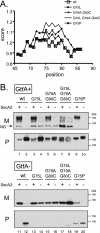Glycine residues in the hydrophobic core of the GspB signal sequence route export toward the accessory Sec pathway
- PMID: 17369296
- PMCID: PMC1913339
- DOI: 10.1128/JB.00027-07
Glycine residues in the hydrophobic core of the GspB signal sequence route export toward the accessory Sec pathway
Abstract
The Streptococcus gordonii cell surface glycoprotein GspB mediates high-affinity binding to distinct sialylated carbohydrate structures on human platelets and salivary proteins. GspB is glycosylated in the cytoplasm of S. gordonii and is then transported to the cell surface via a dedicated transport system that includes the accessory Sec components SecA2 and SecY2. The means by which the GspB preprotein is selectively recognized by the accessory Sec system have not been characterized fully. GspB has a 90-residue amino-terminal signal sequence that displays a traditional tripartite structure, with an atypically long amino-terminal (N) region followed by hydrophobic (H) and cleavage regions. In this report, we investigate the relative importance of the N and H regions of the GspB signal peptide for trafficking of the preprotein. The results show that the extended N region does not prevent export by the canonical Sec system. Instead, three glycine residues in the H region not only are necessary for export via the accessory Sec pathway but also interfere with export via the canonical Sec route. Replacement of the H-region glycine residues with helix-promoting residues led to a decrease in the efficiency of SecA2-dependent transport of the preprotein and a simultaneous increase in SecA2-independent translocation. Thus, the hydrophobic core of the GspB signal sequence is responsible primarily for routing towards the accessory Sec system.
Figures






References
-
- Adams, H., P. A. Scotti, H. De Cock, J. Luirink, and J. Tommassen. 2002. The presence of a helix breaker in the hydrophobic core of signal sequences of secretory proteins prevents recognition by the signal-recognition particle in Escherichia coli. Eur. J. Biochem. 269:5564-5571. - PubMed
-
- Arbely, E., Z. Granot, I. Kass, J. Orly, and I. T. Arkin. 2006. A trimerizing GxxxG motif is uniquely inserted in the severe acute respiratory syndrome (SARS) coronavirus spike protein transmembrane domain. Biochemistry 45:11349-11356. - PubMed
-
- Ausubel, F. M., R. Brent, R. E. Kingston, D. D. Moore, J. G. Seidman, J. A. Smith, and K. Struhl. 1997. Current protocols in molecular biology. John Wiley & Sons, New York, NY.
-
- Bendtsen, J. D., H. Nielsen, G. von Heijne, and S. Brunak. 2004. Improved prediction of signal peptides: SignalP 3.0. J. Mol. Biol. 340:783-795. - PubMed
Publication types
MeSH terms
Substances
Grants and funding
LinkOut - more resources
Full Text Sources

